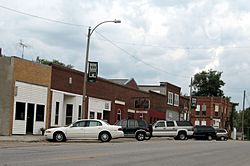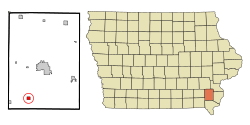Salem, Iowa facts for kids
Quick facts for kids
Salem, Iowa
|
|
|---|---|

Downtown Salem, Iowa
|
|

Location of Salem, Iowa
|
|
| Country | |
| State | |
| County | Henry |
| Area | |
| • Total | 0.63 sq mi (1.63 km2) |
| • Land | 0.63 sq mi (1.62 km2) |
| • Water | 0.00 sq mi (0.01 km2) |
| Elevation | 709 ft (216 m) |
| Population
(2020)
|
|
| • Total | 394 |
| • Density | 629.39/sq mi (243.09/km2) |
| Time zone | UTC-6 (Central (CST)) |
| • Summer (DST) | UTC-5 (CDT) |
| ZIP code |
52649
|
| Area code(s) | 319 |
| FIPS code | 19-70230 |
| GNIS feature ID | 2396527 |
Salem is a small city located in Henry County, Iowa, in the United States. As of the 2020 census, 394 people lived there.
Contents
History of Salem
Salem was first settled by a group called the Quakers. Quakers are a religious group known for their peaceful beliefs. They wanted Salem to be a community where their faith was central.
In 1835, a man named Aaron Street found this empty spot. He thought it was a wonderful place. He decided to bring his family and animals here. He named the new city Salem. This name was special because it was like the city of their ancestors.
Another Quaker, Isaac Pigeon, also came to the area. He and his family were the first citizens of Salem. They worked with Peter Boyer to invite other Quakers to move west and join them.
Early Quaker Community
By 1837, Quakers were holding meetings in their homes. The village was officially planned in 1839 by Aaron Street Jr. and Peter Boyer. Soon after, a special meeting house was built for the community. Even though Quakers started Salem, people from other Christian groups also moved there. So, it was never only a Quaker town.
Salem and the Underground Railroad
Salem was very important for the Underground Railroad. This was a secret network that helped enslaved people escape to freedom. Salem was only about 20 miles from the Missouri border. This made it a key stop for those seeking freedom.
A famous abolitionist from Salem was Henderson Lewelling. Abolitionists were people who wanted to end slavery. His house on West Main Street is a historic site. It is listed as an Underground Railroad station.
The Quakers in Salem agreed that slavery was wrong. However, they had different ideas about actively helping enslaved people escape. Some believed in direct action, while others did not. In 1846, 50 members, including Lewelling, were removed from the Quaker community because of these differences.
Lewelling's Fruit Trees
In 1847, the Lewelling family left Salem. They traveled along the Oregon Trail in a covered wagon. They had a special wagon designed to carry over 700 young fruit and nut trees. These included apples, pears, peaches, and cherries. The trees that survived became the starting point for many early orchards in the Pacific Northwest.
Whittier College in Salem
The Society of Friends also started a college in Salem. It was called Whittier College. This college was open from 1868 to 1910. It is not related to the Whittier College in California.
Geography of Salem
Salem covers a total area of about 0.61 square miles (1.6 square kilometers). All of this area is land.
Population and People
| Historical populations | ||
|---|---|---|
| Year | Pop. | ±% |
| 1880 | 524 | — |
| 1890 | 551 | +5.2% |
| 1900 | 548 | −0.5% |
| 1910 | 501 | −8.6% |
| 1920 | 494 | −1.4% |
| 1930 | 460 | −6.9% |
| 1940 | 457 | −0.7% |
| 1950 | 473 | +3.5% |
| 1960 | 442 | −6.6% |
| 1970 | 458 | +3.6% |
| 1980 | 463 | +1.1% |
| 1990 | 453 | −2.2% |
| 2000 | 464 | +2.4% |
| 2010 | 383 | −17.5% |
| 2020 | 394 | +2.9% |
| Source: and Iowa Data Center Source: |
||
2020 Census Information
In 2020, the city of Salem had 394 people living there. There were 176 households. The population density was about 629 people per square mile.
Most of the people in Salem were White (92.9%). A small number were Black or African American (0.3%), Native American (0.3%), or Asian (0.8%). About 2.3% were from other races, and 3.6% were from two or more races. About 2.8% of the population was Hispanic or Latino.
The average age in Salem was 44.5 years old. About 20.3% of residents were under 20 years old. About 22.6% were 65 years or older. The population was almost evenly split between males (48.7%) and females (51.3%).
2010 Census Information
In 2010, Salem had 383 people. There were 176 households. The population density was about 627 people per square mile.
Most of the people in Salem were White (97.1%). A small number were African American (0.5%), Native American (0.3%), or Asian (0.8%). About 1.3% were from two or more races. About 2.6% of the population was Hispanic or Latino.
The average age in Salem was 44.6 years old. About 21.4% of residents were under 18 years old. About 19.1% were 65 years or older. The population was 44.1% male and 55.9% female.
Education in Salem
The Mount Pleasant Community School District manages the public schools in the area. Salem Elementary School is located within Salem. Older students attend Mount Pleasant Community Middle School and Mount Pleasant Community High School.
Notable People from Salem
Many interesting people have connections to Salem:
- Grenville Beardsley: He was the Attorney General for Illinois.
- Frank E. Garretson: He was a Brigadier General in the U.S. Marine Corps.
- Lorenzo D. Lewelling: He served as the Governor of Kansas.
- Thomas Poulter: He was an Antarctic explorer and a geophysical scientist.
- William Savage: He was an ornithologist (someone who studies birds) and a painter.
See also
 In Spanish: Salem (Iowa) para niños
In Spanish: Salem (Iowa) para niños

